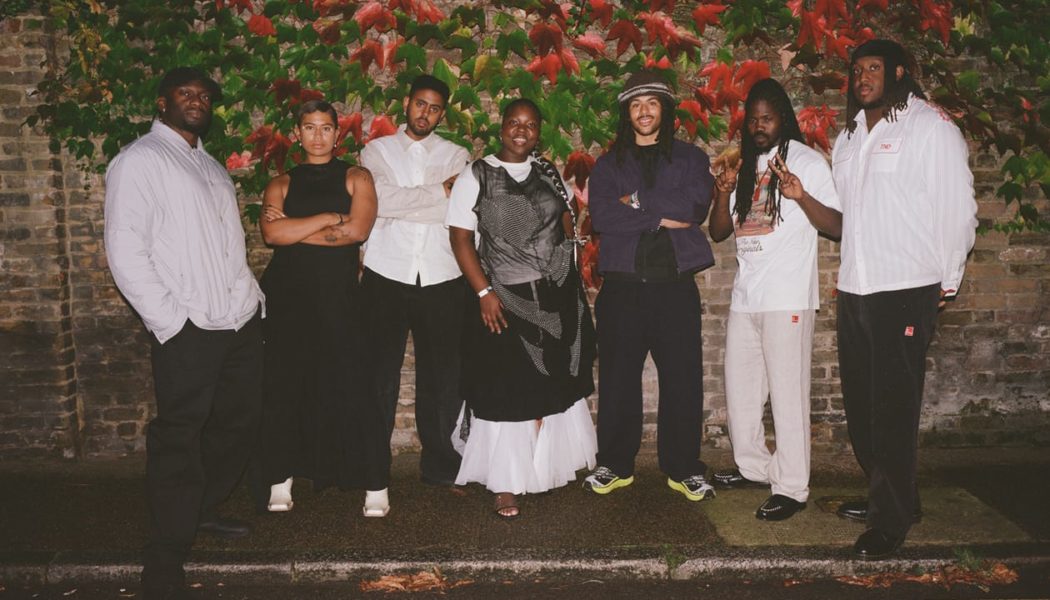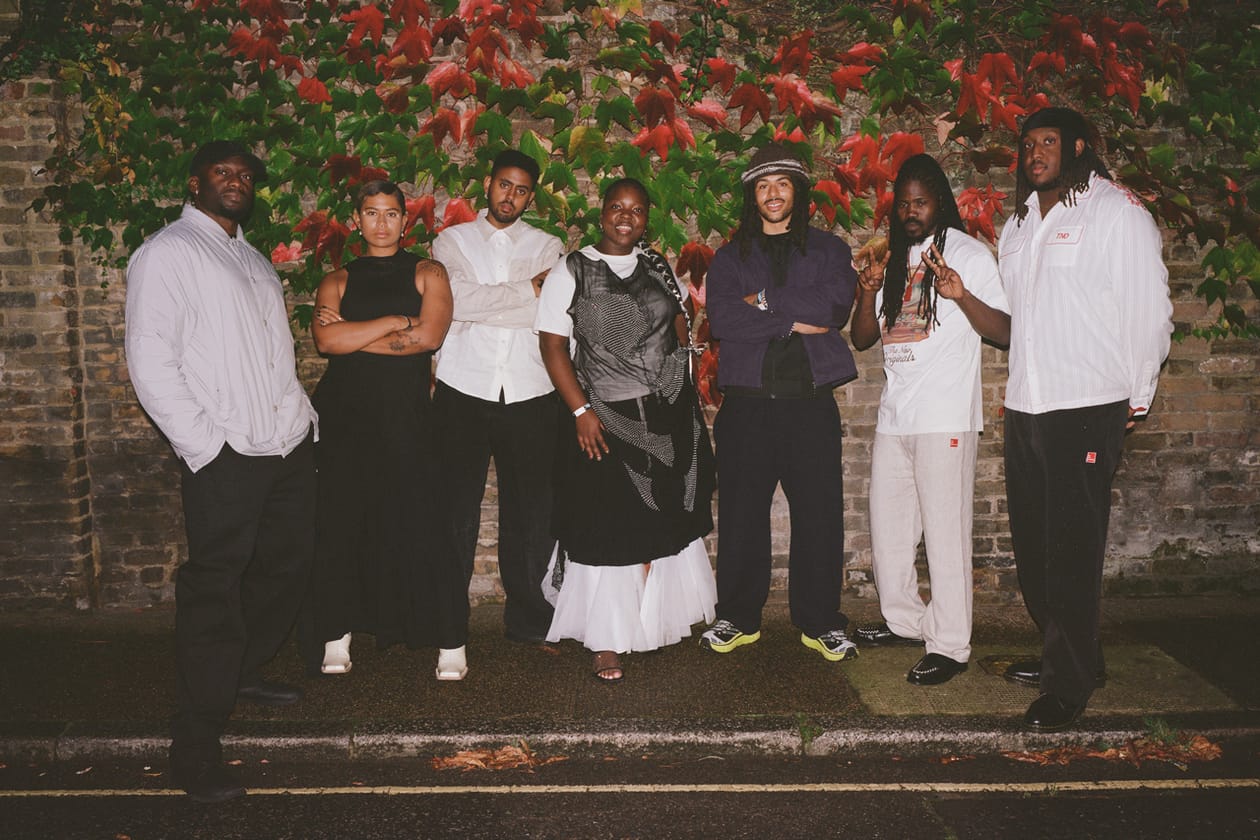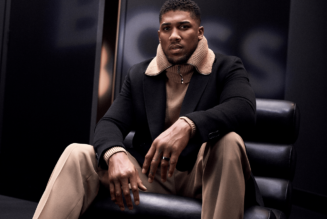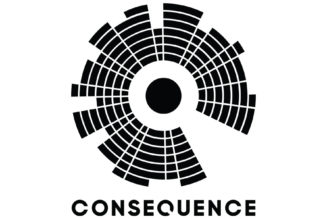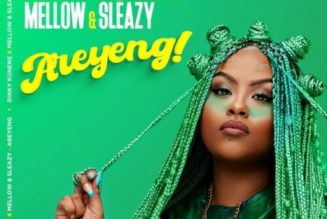The palo santo was lit. A row of sneakers — HOKA, norda and ASICS among them — was neatly assembled on a shoe rack just outside the door, and a half-dozen sockless figures filed into a room at the back of USM Modular Furniture‘s New York City flagship room to take a seat. The sliding door was softly shut, and a reverent silence filled the room as the mammoth OJAS Listening Room installation hummed to life, seemingly buzzing with the energy of the surrounding Soho streets.
It was time for two of Kokoroko‘s eight members (and a few interlopers, from publicists to label reps) to listen to the test press of Get The Message, the band’s brand-new four-track EP and first full project since 2022’s highly-regarded Could We Be More. The band was back in New York City to begin their first extended US tour after several one-off dates earlier in the year that were held everywhere from New York City’s intimate Le Poisson Rouge to the cavernous stages of Coachella. As Kokoroko’s new project flowed through the speakers, each snare hit, high note, and melody crackled with the energy that could only be brought by a new chapter.
Founded in 2017 by percussionist Onome Edgeworth and trumpeter/vocalist Sheila Maurice-Grey, Kokoroko’s music is known for an easy-going, yet richly layered, beauty. It’s a beauty that draws in a casual listener with a catchy, heartfelt harmony or memorable riff, but also provides a rich melange of inspirations for a trained ear, from afrobeat to jazz, soul, funk, and beyond.
That unique sound first garnered the group a following in 2018, when “Abusey Junction,” a track featured on We Out Here – the Brownswood Recordings compilation album that celebrated London’s jazz scene – went viral (at the time of writing, it’s sitting at 57 million views on YouTube and is just shy of 70 million plays on Spotify). Since then, the band’s profile has only grown, thanks to 2019’s self-titled EP, a handful of single releases, and, most notably, 2022’s Could We Be More, the band’s debut album.
Get The Message, slated to release on November 1, is four vastly different tracks, from the bouncing percussion and falsetto vocals of “Three Piece Suit” to the laid-back groove and spacy synths of “Higher.” “The project is definitely a marker of change,” says Maurice-Grey. “All four songs are so different, but they come together for a cohesive feeling.”
And it’s that openness to difference, combined with an embrace of imperfections that allows Kokoroko to create in the way that they do. “When you put your creation out into the world and let it go instead of overthinking it, the art you made takes on its own life, its own meaning,” notes Edgeworth, with the EP’s playthrough having finished and a freshly-started Kenny Dorham vinyl providing sweet background music. “Your first instrument is your ears.”
This is your guys’ first time hearing Get the Message on wax — on these incredible speakers, nonetheless. Do you generally have a good idea of how something is going to sound on record, or are you ever surprised when you play it back?
Sheila Maurice-Grey: It’s nice to hear it in context, especially on speakers like these. During the mixing stage, you can get in a bit of a rut and your ears can get tired.
Onome Edgeworth: It’s important to play a project on several different speakers. You can really hear every little detail on a hi-fi system like this, so that’s important — but it’s also essential to play it through a phone speaker and small Bluetooth speakers as well, to make sure it sounds good through all mediums.
Kokoroko came up as part of a fantastic London jazz scene alongside peers like Ezra Collective and Nubya Garcia. What was being a part of that scene in its early days like and how did it influence your sound?
OE: We always say that if one person wins, we all do. We’ve all benefited from each other’s existence and growth. When one of your contemporaries pushes the envelope or raises the standard, it inspires you to start doing the same. When that happens, people really start finding themselves musically, finding their individuality. We don’t feel special: we feel like we always have to work, both for our good and the good of our community. It’s a really beautiful way to grow.
It seems as if there’s a real collaborative spirit that runs through the scene.
SMG: Absolutely. You mentioned Nubya Garcia, for example. I’ve known her since I was 18, and have played on all of her albums. Everyone tries to raise the bar in their own way, and though there’s this “box” of “UK Jazz” that we can get lumped into sometimes, everyone is developing their own sound and individuality, which is beautiful to see.
“If you care about labels too much it kills your creative viewpoint. We really try to focus on being inspired by the different sounds we hear instead of putting labels on our music.”
Kokoroko’s music is often described as a fusion of jazz and afrobeat. Do you care for any of those labels? How would you describe your music?
OE: I think that if you care about labels too much it kills your creative viewpoint. We really try to focus on being inspired by the different sounds we hear instead of putting labels on our music. I’ve been listening to a lot of music from Sheila’s country, Sierra Leone, recently, and although it could be described as “folk music,” I just try to keep an open ear and mind. However, I do think that labels serve a purpose for listeners. They help you promote your music and the people who are listening to it identify it.
The band’s big break came in 2018 when “Abusey Junction” went viral. When I checked this morning, it was just shy of 70 million plays on Spotify …
SMG: Wait, what? That’s wild [laughs].
Do you guys remember what it felt like making that track? Is it a surprise to you that it blew up like that?
SMG: 100%, it was a surprise. Even when it hit a million plays, we were like …
OE: “Why?” [both laugh].
SMG: When we wrote that song, [guitarist] Oscar Jerome was in the band, and he, Onome, and myself were in Gambia doing a project.
OE: The song is actually named after the road my family’s house is on. Oscar and I were sitting on the roof, and he was working on some licks, one of which became the basis of that song. Right after we came back, we got invited to contribute a song to We Out Here.
SMG: We actually didn’t have a drummer in the band at the time, and were like “What can we do without percussion? Let’s use those ideas from the roof.” That version you hear on the record is actually the first time we properly played it.
OE: That uncertainty is honestly the best thing that could have happened to us. “Abusey Junction” didn’t feel like a complete idea because of where it came from, but we liked it and decided to let that creative impulse out. When you put your creation out into the world and let it go instead of overthinking it, the art you made takes on its own life, its own meaning. It’s taking a picture of a moment. We always want to improve at our craft because if we do the pictures of those moments become increasingly clear.
We learn more about that song all the time. We’ve heard some really beautiful things: people giving birth to it, passing away to it, a baby’s first kick coming while it’s playing … honestly, a lot of stories about babies being made to it too [laughs].
“We always try to be honest about where we’re at as musicians. Setting intentions, like ‘What do we want this music to be and what do we want people to walk away from it with?’”
How do you guys keep that raw feeling from the early days of the group alive as you continue to evolve in your craft?
SMG: We always try to be honest about where we’re at as musicians. Setting intentions, like “What do we want this music to be and what do we want people to walk away from it with?” Even going further, we ask ourselves that question before a show. It’s important to be honest to the time a piece was written in.
You mentioned live shows — how does being honest in your music translate into a performance instead of a recording?
OE: Yohan [Kebede, Kokoroko keyboardist] and I were recently talking about how, if you want to make good art, art that lasts, you have to stay in tune with all the conversations that are happening in the world and in your personal life. You have to be present. That extends to a show. The second you start playing, a conversation with the audience begins. You can ignore that or you can lean into it, and we always try to lean into it. The same song can be completely different from night to night because of the crowd’s energy. If Sheila’s got space to solo and the crowd’s on a hundred, she’s gonna go there with them. If it’s a more of a relaxed, engaged vibe, it’s gotta be a more sensitive, gentle solo. Staying part of that conversation inspires you as a musician. Your first instrument is your ears.
There are four vastly different conversations being had on Get the Message. What excites you about it being out to the world?
SMG: That it’s a marker of change for us as a group. All four songs are so different, but they come together for a cohesive project. To be honest, we were writing for our next album. “Higher” was the first song we’d written for it, and it just so happened that these four specific songs sounded great as their own project.
“Three Piece Suit” was the first single from the project to be released. There’s a really rich story of family heritage behind it — and that deep meaning has been a constant in Kokoroko’s music since the band was founded. How does sharing those stories play into having a “conversation” with your listeners?
OM: The beautiful thing about music is that the audience doesn’t have to get the story as long as the energy speaks to them. A feeling is what we want to communicate. We’re very blessed to be living the way that we are, and that comes from the foundation previous generations laid for us. My grandfather had a story, his father had a story. Coming to London from Africa wasn’t an easy journey for them, but it’s provided us with this beautiful life, so we wanted to celebrate and commemorate that. I hope when people hear that, the energy translates to their own lives and what they’re feeling.
“Our intention is always to add something to the story of this music, not just re-tell it.”
Speaking of previous generations, you’d said in a past interview that you felt that jazz and afrobeat shouldn’t stay with your parents’ generation. How do you guys keep that spirit and impact of the music alive without being too indebted to it?
SMG: That’s been an ongoing conversation because we’re never going to be like Fela Kuti and Ibo Taylor. We haven’t grown up in the same way. I think there’s beauty in honoring that music but trying to pave a new way as well. It can make for a weird and wonky mix of inspirations, but that’s honestly us just trying to find our voice and having fun.
OM: I think the best way to honor these people that were groundbreaking is to try and live as they did — pushing boundaries and creating new things — instead of doing exactly what they’ve already done. Our intention is always to add something to the story of this music, not just re-tell it.
In an increasingly digital world, it seems like a lot of younger listeners are gravitating towards music with a very “human” feel, made with live instrumentation and a healthy dose of in-the-moment exploration, like yours. What do you think draws a listener to your music? The human feeling, the honesty?
SMG: I think it’s literally what you just said. There seems to be a yearning for honest human expression, and people are drawn to that element of our music. People want to feel like they can relate to something, connect to something. It’s just that simple to me.
OM: Honestly, I think hearing mistakes helps as well. When we listen back to our music, we’re always like “That shouldn’t be like that, this shouldn’t be like that.” [both laugh]. The other day, Azekel, the vocalist on “Three Piece Suit” was telling us that there was a sound on our first EP that we didn’t have anymore and that he thought we should capture it. I was like “Mate, we ran away from that sound because it feels like a mistake to us!” That’s what draws people in, though. You might move on from who you are at a certain time, but as long as you’re another version of yourself in the same way it’ll always connect.
Do you battle with being perfectionists or just let the chips fall where they may?
OM: Every single song we’ve released, I’d change massively if I sat with it for a while [Sheila laughs]. We do really overthink a lot of things, which is naturally part of the process. There’s a lot of letting go needed, man. It’s made easier by the fact that the rest of the band is wonderful. You’ll be listening to them play, and it’s almost like you’re negotiating with one another. For example, I might like for something to go a certain way, but, if Sheila feels it would be better another way, I know she’s a great musician so I’ll be like “Let’s let this happen.” Then, without fail, I’ll listen back later and it’s sick.
SMG: Or you’ll listen back and be like “Actually, I was right!” But there’s a great give-and-take. Writing music has always come really naturally to us, that give and take, negotiating with a half-dozen voices.
OM: The fun part is that we get to experience our music in a way a lot of people don’t because, as an eight-piece band, there are a lot of voices at once. It’s a beautiful thing. I just wish finishing a piece of music was as easy as starting it.
What’s next for Kokoroko after the EP release and the US tour?
OM: A flipping holiday, man. December is empty!
SMG: We’re finishing up the album too, and are really excited to release that next year. Hopefully do some more tours in 2025 after the break too.
Last question: if you could hear any one record on this sound system besides your own, what are you picking?
SMG: Oh … that’s not fair!
OM: If I’m listening on a good system, it’s D’Angelo‘s Voodoo for me, straight away. I know it inside out, I love how it sounds, and understand it on a system. It’s a very safe choice, but it’s just what I do whenever I have a chance to play music on some great speakers.
SMG: … I don’t know! My first answer was going to be Hard Groove by The RH Factor, but I’ve been thinking about Ibo Taylor’s album My Love and Music. It’s such a joyous album and it would be nice to hear it here.
‘Get the Message’ will be available on streaming platforms and vinyl November 1 (vinyl pre-orders are open now). Head to the band’s website for info on US, Canada and European tour dates.
